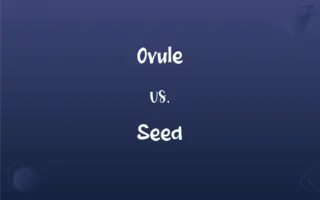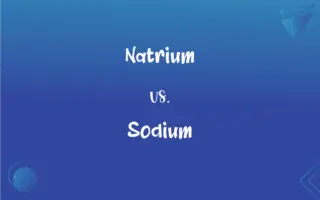Oxygenated Blood vs. Deoxygenated Blood: What's the Difference?
Edited by Aimie Carlson || By Harlon Moss || Updated on October 26, 2023
Oxygenated blood carries a high concentration of oxygen from the lungs to the body's tissues, while deoxygenated blood has less oxygen, transporting carbon dioxide from the tissues to the lungs.

Key Differences
Oxygenated blood and deoxygenated blood differ primarily in oxygen content and function. Oxygenated blood is rich in oxygen, as it has absorbed this vital gas from the lungs, and is responsible for nourishing body cells. In contrast, deoxygenated blood contains a reduced amount of oxygen and is tasked with carrying away waste products like carbon dioxide from body cells to the lungs for exhalation.
The colors of oxygenated blood and deoxygenated blood are distinct due to their oxygen content. Oxygenated blood displays a bright red hue, thanks to the oxygen-bound hemoglobin. On the other hand, deoxygenated blood exhibits a darker red or bluish tint because of the absence of this bond.
In the circulatory system, the heart plays a pivotal role in handling both oxygenated blood and deoxygenated blood. The left side of the heart pumps oxygenated blood to the rest of the body via arteries, ensuring cells receive the oxygen they need. Conversely, the right side of the heart receives deoxygenated blood from veins, sending it to the lungs to offload carbon dioxide and pick up fresh oxygen.
Interestingly, the distinction between oxygenated blood and deoxygenated blood is not just functional but also structural. Oxygenated blood travels primarily through arteries, excluding the pulmonary artery, while deoxygenated blood mainly flows through veins, with the pulmonary veins being the exception.
Physiologically, the balance between oxygenated blood and deoxygenated blood is crucial. Efficient oxygen delivery by oxygenated blood ensures proper cell function, while the timely removal of waste by deoxygenated blood guarantees a toxin-free internal environment.
ADVERTISEMENT
Comparison Chart
Oxygen Content
High
Low
Color
Bright red
Darker red or bluish
Main Function
Delivers oxygen to body tissues
Removes carbon dioxide from tissues
Primary Circulatory Path
Through arteries (except pulmonary artery)
Through veins (except pulmonary veins)
Bond with Hemoglobin
Oxygen is bound to hemoglobin, forming oxyhemoglobin
Oxygen is released, and carbon dioxide may bind slightly
ADVERTISEMENT
Oxygenated Blood and Deoxygenated Blood Definitions
Oxygenated Blood
Blood that has absorbed oxygen from the lungs.
Oxygenated blood gives tissues the oxygen they need for energy.
Deoxygenated Blood
Blood that carries waste products like carbon dioxide.
Deoxygenated blood transports carbon dioxide to the lungs for exhalation.
Oxygenated Blood
The type of blood that nourishes organs and tissues.
Oxygenated blood ensures the brain gets enough oxygen to function properly.
Deoxygenated Blood
Blood that appears darker due to less oxygen.
The bluish tint in our veins is due to deoxygenated blood within.
Oxygenated Blood
Blood with hemoglobin bound to oxygen.
The bright red hue of oxygenated blood indicates its richness in oxygen.
Deoxygenated Blood
Blood with a reduced oxygen content.
After delivering its oxygen, the deoxygenated blood returns to the heart.
Oxygenated Blood
Blood rich in oxygen.
The heart pumps oxygenated blood to nourish the entire body.
Deoxygenated Blood
The type of blood primarily flowing through veins.
The superior vena cava brings deoxygenated blood from the upper body to the heart.
Oxygenated Blood
Blood primarily transported by arteries.
The main artery, the aorta, carries oxygenated blood from the heart to the body.
Deoxygenated Blood
Blood ready to be reoxygenated in the lungs.
Deoxygenated blood is pumped to the lungs to receive fresh oxygen.
FAQs
What is oxygenated blood?
Oxygenated blood is blood that is rich in oxygen, typically found in arteries.
What color is oxygenated blood?
It’s bright red due to the presence of oxygen.
Where is oxygenated blood found?
It's primarily found in the arteries, except for the pulmonary artery.
What is deoxygenated blood?
Deoxygenated blood is blood that has given up its oxygen to the body's tissues and is found mostly in veins.
What color is deoxygenated blood?
It’s darker red or maroon, not blue as often depicted.
How does blood become oxygenated?
Blood becomes oxygenated in the lungs where it picks up oxygen and releases carbon dioxide.
How do health issues affect oxygenated and deoxygenated blood?
Conditions like heart and lung diseases can affect the oxygenation and flow of blood.
Where is deoxygenated blood found?
Mostly in veins, except for the pulmonary veins.
What carries oxygen in the blood?
Hemoglobin in red blood cells carries oxygen.
What is the role of the heart in pumping these types of blood?
The heart pumps oxygenated blood to the body and deoxygenated blood to the lungs.
Do all animals have oxygenated and deoxygenated blood?
Most animals with circulatory systems have this distinction, but there are variations.
How does blood become deoxygenated?
As blood circulates through the body, it delivers oxygen to cells and becomes deoxygenated.
What happens to deoxygenated blood in the lungs?
It releases CO2, becomes oxygenated, and returns to the heart.
Why is oxygenated blood important?
It delivers essential oxygen to body tissues for energy and cellular function.
Does deoxygenated blood carry CO2?
Yes, it carries carbon dioxide from the tissues back to the lungs.
Is deoxygenated blood useless?
No, it's vital for removing waste like CO2 from the body.
Can veins carry oxygenated blood?
Yes, in the case of pulmonary veins returning blood from the lungs to the heart.
What is the oxygen saturation level in oxygenated blood?
Typically around 95-100% in healthy individuals.
What is the oxygen saturation level in deoxygenated blood?
It's lower, varying based on tissue oxygen consumption.
Can arteries carry deoxygenated blood?
Yes, the pulmonary artery carries deoxygenated blood from the heart to the lungs.
About Author
Written by
Harlon MossHarlon is a seasoned quality moderator and accomplished content writer for Difference Wiki. An alumnus of the prestigious University of California, he earned his degree in Computer Science. Leveraging his academic background, Harlon brings a meticulous and informed perspective to his work, ensuring content accuracy and excellence.
Edited by
Aimie CarlsonAimie Carlson, holding a master's degree in English literature, is a fervent English language enthusiast. She lends her writing talents to Difference Wiki, a prominent website that specializes in comparisons, offering readers insightful analyses that both captivate and inform.





































































